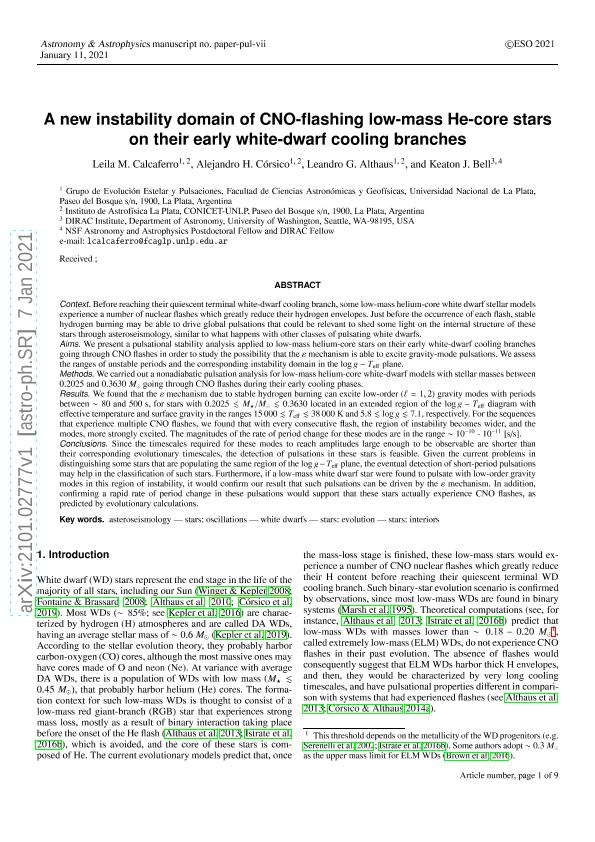Mostrar el registro sencillo del ítem
dc.contributor.author
Calcaferro, Leila Magdalena

dc.contributor.author
Corsico, Alejandro Hugo

dc.contributor.author
Althaus, Leandro Gabriel

dc.contributor.author
Bell, Keaton J.
dc.date.available
2021-08-11T15:20:26Z
dc.date.issued
2021-03
dc.identifier.citation
Calcaferro, Leila Magdalena; Corsico, Alejandro Hugo; Althaus, Leandro Gabriel; Bell, Keaton J.; A new instability domain of CNO-flashing low-mass He-core stars on their early white-dwarf cooling branches; EDP Sciences; Astronomy and Astrophysics; 647; A140; 3-2021; 1-8
dc.identifier.issn
0004-6361
dc.identifier.uri
http://hdl.handle.net/11336/138157
dc.description.abstract
Before reaching their quiescent terminal white-dwarf cooling branch, some low-mass helium-core white dwarf stellar models experience a number of nuclear flashes which greatly reduce their hydrogen envelopes. Just before the occurrence of each flash, stable hydrogen burning may be able to drive global pulsations that could be relevant in shedding some light on the internal structure of these stars through asteroseismology, similarly to what occurs with other classes of pulsating white dwarfs. Aims: We present a pulsational stability analysis applied to low-mass helium-core stars on their early white-dwarf cooling branches going through CNO flashes in order to study the possibility that the ε mechanism is able to excite gravity-mode pulsations. We assess the ranges of unstable periods and the corresponding instability domain in the log g ‒ Teff plane. Methods: We carried out a nonadiabatic pulsation analysis for low-mass helium-core white-dwarf models with stellar masses between 0.2025 and 0.3630 M⊙ going through CNO flashes during their early cooling phases. Results: We found that the ε mechanism due to stable hydrogen burning can excite low-order (ℓ = 1, 2) gravity modes with periods between ∼80 and 500 s for stars with 0.2025 ≲ M⋆/M⊙ ≲ 0.3630 located in an extended region of the log g ‒ Teff diagram, with effective temperature and surface gravity in the ranges 15 000 ≲ Teff ≲ 38 000 K and 5.8 ≲ log g ≲ 7.1, respectively. For the sequences that experience multiple CNO flashes, we found that with every consecutive flash, the region of instability becomes wider and the modes are more strongly excited. The magnitudes of the rate of period change for these modes are in the range of ∼10‒10-10‒11 [s/s]. Conclusions: Since the timescales required for these modes to reach amplitudes large enough to be observable are shorter than their corresponding evolutionary timescales, the detection of pulsations in these stars is feasible. Given the current problems in distinguishing some stars that populate the same region of the log g ‒ Teff plane, the eventual detection of short-period pulsations may help in the classification of such stars. Furthermore, if a low-mass white dwarf star were found to pulsate with low-order gravity modes in this region of instability, it would confirm our result that such pulsations can be driven by the ε mechanism. In addition, confirming a rapid rate of period change in these pulsations would support the idea that these stars actually experience CNO flashes, as has been predicted by evolutionary calculations.
dc.format
application/pdf
dc.language.iso
eng
dc.publisher
EDP Sciences

dc.rights
info:eu-repo/semantics/openAccess
dc.rights.uri
https://creativecommons.org/licenses/by-nc-sa/2.5/ar/
dc.subject
asteroseismology
dc.subject
stars: oscillations
dc.subject
white dwarfs
dc.subject
stars: evolution
dc.subject
stars: interiors
dc.subject.classification
Astronomía

dc.subject.classification
Ciencias Físicas

dc.subject.classification
CIENCIAS NATURALES Y EXACTAS

dc.title
A new instability domain of CNO-flashing low-mass He-core stars on their early white-dwarf cooling branches
dc.type
info:eu-repo/semantics/article
dc.type
info:ar-repo/semantics/artículo
dc.type
info:eu-repo/semantics/publishedVersion
dc.date.updated
2021-07-01T14:25:25Z
dc.journal.volume
647
dc.journal.number
A140
dc.journal.pagination
1-8
dc.journal.pais
Francia

dc.journal.ciudad
Paris
dc.description.fil
Fil: Calcaferro, Leila Magdalena. Universidad Nacional de La Plata. Facultad de Ciencias Astronómicas y Geofísicas; Argentina. Consejo Nacional de Investigaciones Científicas y Técnicas. Centro Científico Tecnológico Conicet - La Plata. Instituto de Astrofísica La Plata. Universidad Nacional de La Plata. Facultad de Ciencias Astronómicas y Geofísicas. Instituto de Astrofísica La Plata; Argentina
dc.description.fil
Fil: Corsico, Alejandro Hugo. Universidad Nacional de La Plata. Facultad de Ciencias Astronómicas y Geofísicas; Argentina. Consejo Nacional de Investigaciones Científicas y Técnicas. Centro Científico Tecnológico Conicet - La Plata. Instituto de Astrofísica La Plata. Universidad Nacional de La Plata. Facultad de Ciencias Astronómicas y Geofísicas. Instituto de Astrofísica La Plata; Argentina
dc.description.fil
Fil: Althaus, Leandro Gabriel. Universidad Nacional de La Plata. Facultad de Ciencias Astronómicas y Geofísicas; Argentina
dc.description.fil
Fil: Bell, Keaton J.. University of Washington; Estados Unidos
dc.journal.title
Astronomy and Astrophysics

dc.relation.alternativeid
info:eu-repo/semantics/altIdentifier/url/https://www.aanda.org/10.1051/0004-6361/202039831
dc.relation.alternativeid
info:eu-repo/semantics/altIdentifier/doi/https://doi.org/10.1051/0004-6361/202039831
dc.relation.alternativeid
info:eu-repo/semantics/altIdentifier/arxiv/https://arxiv.org/abs/2101.02777
Archivos asociados
